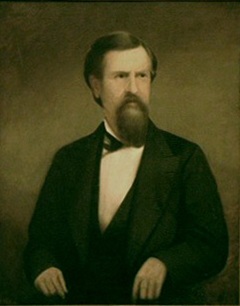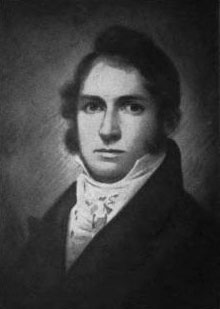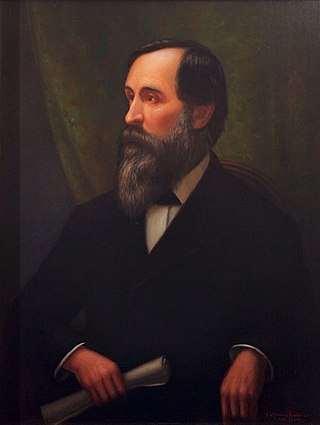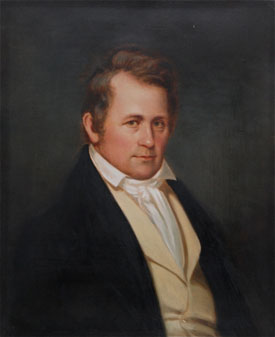Related Research Articles

The Natchez Trace, also known as the Old Natchez Trace, is a historic forest trail within the United States which extends roughly 440 miles (710 km) from Nashville, Tennessee, to Natchez, Mississippi, linking the Cumberland, Tennessee, and Mississippi rivers.

Archibald Alexander was an American Presbyterian theologian and professor at the Princeton Theological Seminary. He served for 9 years as the President of Hampden–Sydney College in Virginia and for 39 years as Princeton Theological Seminary's first professor from 1812 to 1851.

James Davis Porter was an American attorney, politician, educator, and officer of the Confederate Army. He served as the 20th Governor of Tennessee from 1875 to 1879. He was subsequently appointed as Assistant Secretary of State during President Grover Cleveland's first administration, and Minister to Chile in Cleveland's second administration.

Vanderbilt Peabody College of Education and Human Development is the education school of Vanderbilt University, a private research university in Nashville, Tennessee. Founded in 1875, Peabody had a long history as an independent institution before merging with Vanderbilt University in 1979. The school is located on the Peabody Campus of Vanderbilt University in Nashville. The academic and administrative buildings surround the Peabody Esplanade and are southeast of Vanderbilt's main campus.
University of Nashville was a private university in Nashville, Tennessee. It was established in 1806 as Cumberland College. It existed as a distinct entity until 1909; operating at various times a medical school, a four-year military college, a literary arts college, and a boys preparatory school. Educational institutions in operation today that can trace their roots to the University of Nashville include Montgomery Bell Academy, an all-male preparatory school; the Vanderbilt University Medical School; Peabody College at Vanderbilt University; and the University School of Nashville, a co-educational preparatory school.

Robert Weakley was an American politician who represented Tennessee in the United States House of Representatives from 1809 to 1811.

Alney McLean was a United States representative from Kentucky. McLean County, Kentucky, is named in his honor.
Richard Boone Cheatham was an American politician based in Nashville, Tennessee. He was serving as the mayor of Nashville, Tennessee, during the opening years of the Civil War. After the war he served as alderman of the city, and later as a representative to the State House, 1869-1871.

John Berrien Lindsley (1822–1897) was an American Presbyterian minister and educator in Nashville, Tennessee.
Henry C. Hibbs (1882–1949) was an American architect. He designed many buildings on the campus of Vanderbilt University in Nashville, Tennessee, as well as Davidson College in Davidson, North Carolina. He also designed the libraries of Fisk University in Nashville and the University of Tulsa in Tulsa, Oklahoma. He was the recipient of several awards for his architectural work.

Wilkins F. Tannehill (1787–1858) was an American Whig politician and author. He served as the Mayor of Nashville, Tennessee from 1825 to 1827.

Samuel Van Dyke Stout (1786–1850) was an American Whig politician. He served as the Mayor of Nashville, Tennessee from 1841 to 1842.
The following is a timeline of the history of the city of Nashville, Tennessee, United States.

Philip Lindsley (1786–1855) was an American Presbyterian minister, educator and classicist. He served as the acting president of the College of New Jersey from 1822 to 1824, and as the first president of the now-defunct University of Nashville from 1824 to 1850.
Adrian Van Sinderen Lindsley (1814–1885) was an American lawyer, businessman and politician from Tennessee.

Leroy Jones Halsey (1812-1896) was an American Presbyterian scholar and author.

Richland Creek is a stream in the western part of Nashville, Tennessee, in Davidson County. It winds for 28 miles (45 km) through the Nashville suburbs of Belle Meade and Forest Hills and eventually flows into the Cumberland River near Rock Harbor Marina at the end of Robertson Avenue. This is one of at least five streams by the name of "Richland Creek" in various regions of Tennessee.

The Richland–West End Historic District is a historic district on the Western side of Nashville, Tennessee. It comprises approximately a 12-block area consisting mostly of Bungalow/craftsman architecture and about 70 Foursquare-style houses.
Craighead House, at 3710 Westbrook Avenue in Nashville, Tennessee, is a Federal style house built in circa 1810, perhaps 1812. It is one of the oldest brick houses in Nashville. The house's gardens were a featured garden of the Garden Club of Nashville.

The Grand Lodge of Tennessee, officially the Grand Lodge of the Ancient and Honorable Fraternity of Free and Accepted Masons of the State of Tennessee, is the main governing body of Freemasonry within Tennessee. This Grand Lodge was established in Knoxville, Tennessee, on December 27, 1813, by nine Masonic lodges operating within the state. In 2017, the Grand Lodge of Tennessee had a reported membership of 34,858 Master Masons, and by 2020 the membership had fallen only slightly to 33,200.
References
- 1 2 3 A.L.C. (November 1965). "The Continuity of a College". Peabody Journal of Education. 43 (3): 129–132. doi:10.1080/01619566509537326. JSTOR 1491085.
- ↑ "Jno. M. Bass, "Rev. Thomas Craighead," The American Historical Magazine, Vol. 7, No. 1 (January, 1902), pp. 88-96".
{{cite journal}}: Cite journal requires|journal=(help) - 1 2 3 4 Connelly, John Lawrence (December 25, 2009). "Thomas Brown Craighead". The Tennessee Encyclopedia of History and Culture. Tennessee Historical Society and University of Tennessee Press . Retrieved February 13, 2016.
- 1 2 3 Pendleton, Charles S. (September 1966). "The Peabody Semicentennial". Peabody Journal of Education. 44 (2): 119. doi:10.1080/01619566609537406. JSTOR 1490710.
- ↑ "National Register of Historic Places Inventory--Nomination Form: Richland-West End Historic District". National Park Service. Retrieved February 13, 2016.